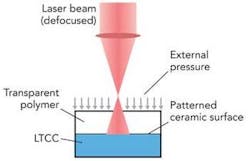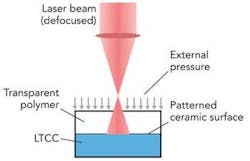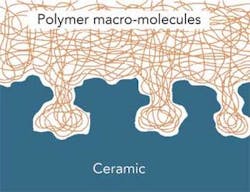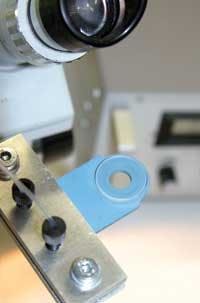Lasers join ceramic and polymer components
A novel joining technique, suitable for manufacturing micro components, enables dissimilar metals to be joined to each other economically
Volker Franke and Udo Klotzbach
A novel joining technique—developed at the Fraunhofer Institute for Material and Beam Technology (IWS-Dresden, Germany) supported by the Fraunhofer Institute for Ceramic Technologies and Systems (IKTS-Dresden, Germany)—improves manufacturing processes for micro-systems engineering in the field of biochemistry and chemical analysis. Here we focus on the direct joining of polymers and ceramics by using laser technology. The goal of the R&D project was to develop inexpensive, multifunctional sensor systems by combining Low Temperature Co-fired Ceramic (LTCC) based sensor and actuator technology with low-cost polymer-based micro-fluidics. Through laser technology, components made of extremely different materials can be joined strongly and durably to each other. Laser technology can also be advantageous for micro-patterning and functionalization of surfaces of LTCCs and polymers.
LTCC technology
The ceramic multi-layer LTCC technology is a well established production process for manufacturing robust microelectronics, sensors (for example, pressure sensors, pH-value measurement, conductivity, resistance measurement) and actuators (for example, piezo actuators). This technology enables the manufacture of three-dimensional, high-power electronic circuits, used for example by the automotive and telecom industry.
Flexible thin foils of unsintered material are the basis of the LTCC technology. These single foils can be geometrically patterned using mechanical machining as well as laser ablation processes. Electrical elements at each foil’s surface can be created by screen printing, for example. In the next step the prefabricated foils are stacked up, pressed, and sintered at about 900 °C. The lack of transparency is a disadvantage of systems made of LTCC, making it difficult to optically monitor processes.
Scientists in the fields of medicine and biology utilizing sensor systems for process monitoring look for the opportunity to optically monitor running processes. The implementation of transparent polymer windows into the ceramic sensor systems would enable the optical detection of inner processes. Complex micro-fluidic systems are commonly not made using LTCC technology. Materials and manufacturing technology make such ceramic elements more expansive than comparable polymer components.
State of the art
Different joining technologies are commonly used in the industry to combine polymer and ceramic components, for example, adherence or mechanical joining technologies. Utilizing adhesives is common in industrial production where the adhesive is brought in between both joining partners and subsequently cured to fix the joint. One disadvantage of this technology is that an additional chemical substance is brought into the system to be joined using material that can lead to unwanted impacts on the functionality of the final system, for example, a biomedical reactor. Scientists using lab-on-a-chip systems or biomedical systems are interested in optical detection of inner processes from outside through transparent windows that are commonly fixed to the ceramic body using adhesives. Many of the adhesive connections are not stable and tight long-term, so delamination or leakage of the window can occur.
Mechanical joining techniques using screws, clamps, or the like offer an alternative to join ceramics and polymers. In this case additional geometric features like holes or notches may need to be integrated into both joining partners, increasing the production efforts. Additional sealing gaskets are necessary to produce sealed assemblies (liquid-tight and gas-proof) of polymer and ceramic elements.
Laser welding is another established industrial joining technique for polymer components, where both joining partners consist of similar thermoplastic polymers. The laser energy transmits (at least partly) through the first joining partner and is absorbed by the underlying second joining partner with external pressure applied to ensure a tight contact and strong joint. The absorbed laser energy leads to a melting and mixing of both components within the contact zone. After solidification the joining area shows the same properties as the basic material.
Novel joining technology
A technique developed at the Fraunhofer IWS enables direct, durable joining of ceramic and polymer components. At first glance a direct joining of the two materials seems to be critical due to the fact that the melting points are extremely different. Common thermoplastic polymers melt below 250 °C and thermal decomposition starts when temperatures exceed 400 °C. In contrast the melting point of ceramic materials lies well above 1000 °C. The extremely different thermal and physical behaviors of these materials are a challenge for joining tasks.
The basic idea of a novel joining technique (see FIGURE 1) is to partly melt the polymer component and to push the molten material into the pores and roughness of the solid ceramic material surface. The joining process is divided into two process steps: surface modification and thermal joining utilizing laser radiation.
In the first processing step the surface of the ceramic element is patterned, for instance, by pulsed laser ablation to ensure a very solid compound of the two partners. In the following thermal process step a laser beam melts a thin layer of the polymer element within the contact area of the joining partners. The laser beam transmits through the transparent polymer part and is absorbed by the ceramic element resulting in a localized, selective warming of the ceramic surface. Heat conduction between the contiguous joining partners results in heating up of the polymeric component, leading to a thin layer of molten polymer material that is forced to move into the surface structures of the ceramic by applying external pressure (see FIGURE 2). After cooling down and solidification both components are firmly joined. Two basic effects ensure the joint: mechanical anchoring of the polymer in the ceramic surface structures and adhesion between the interfacing materials.
In recent R&D work the influence of diverse process parameters (such as laser power, processing speed, joining pressure, temperature within the joining area, and so on) during the thermal joining process was investigated and optimized. To monitor and control the joining temperature a pyrometer-based temperature measurement and laser power control was implemented. So far two different laser sources have been utilized—a rod type Nd:YAG laser and a fiber laser system. Fiber lasers are characterized by a higher efficiency and improved beam quality compared to rod type solid-state lasers. In general other laser sources like diode lasers are suitable as well.
Because of the potential of the LTCC technology regarding micro- and sensor systems, R&D was mainly focused on this kind of ceramic. Different polymer materials have been successfully tested and compared, for example, PC, PMMA, SAN, and PETG. The surface pattern of the solid joining partner (in our case, ceramic) has a crucial influence on the properties of the joint’s strength and durability. A wide field of different surface patterns has been created, joined, and compared using different short-pulsed laser sources. Structural dimensions like width and depth have been varied for different basic geometries like single craters or linear notches. Various structural and process parameters influence each other and the joint’s properties. Handling and preparation of the components also influences the performance as well. Thus a complex optimization and adjustment of all influencing parameters is important to produce an optimal joining result. Hermetic joints with tensile strengths up to 25 N/mm2 have been produced.
Lab-on-a-chip systems
Based on this novel joining technology several bioreactor and lab-on-a-chip systems have been manufactured for research and testing purposes. Applying the optimized joining technology, LTCC-based ceramic sensors were combined with transparent polymer elements, for example, plane windows or micro-fluidic components. The Fraunhofer Institute IKTS supported the development work by manufacturing the ceramic elements containing different sensors and parts of the micro-fluidic systems. With the lab-on-a-chip system shown in FIGURE 3 the cellular growth inside the integrated microbiological reactor can be monitored and controlled under defined thermal and biochemical conditions. By applying transparent polymer windows it is now possible to monitor the inner processes optically for instance by microscopy. Another option is to use optical photometry, for example fluorescence measurement, to analyze biochemical changes inside the reactor.
FIGURE 4 shows a ceramic-polymer sensor system with an integrated multi-electrode array to measure electrical signals from cell cultures. The ceramic sensor has been joined to a polymer micro-fluidic element by means of the novel joining technology. Growing cell cultures can be fed with nutritional liquid and various reagents by the polymer fluidic.
In parallel R&D projects a technology was developed at the Fraunhofer IWS wherein polymer surfaces can be patterned and functionalized by pulsed laser irradiation within an active gas atmosphere. This allows influencing the accretion of cells in specific surface areas making it possible to specifically biologically functionalize the polymer components before joining them to the sensor system.
Promising applications and markets for the novel joining technique are to be seen in the fields of chemical and biological analysis, for instance screening tests in pharmacy companies, environmental analysis in chemical facilities, and analysis in food industry and medical technology.
Outlook
One goal of ongoing research activities at the IWS will be to produce improvements in the tensile strength of the joints. Further optimizations target the surface patterning and surface preparation. Future studies will also transfer the joining process to other material combinations, for example additional polymers or new ceramics and to transfer the technology to joints of polymers and semiconductors or metals. By this means the application spectrum can be extended into the field of micro-systems technology and micro-electronics.
Volker Franke ([email protected]) is a research associate and Dr. Udo Klotzbach ([email protected]) is a team leader in Micro-/Bio-Technology at Fraunhofer IWS, Dresden, Germany




